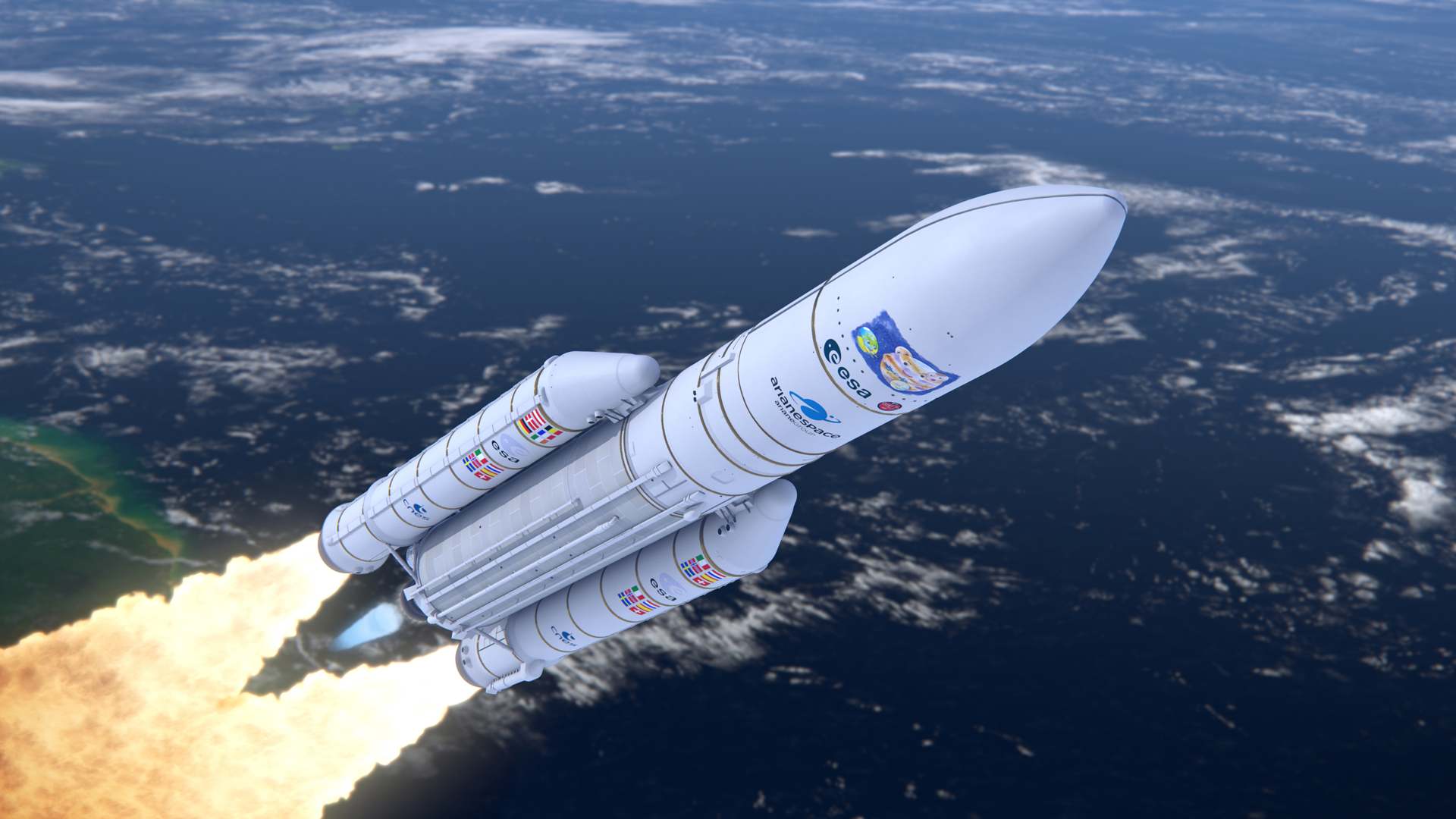How to watch the launch of Europe's JUICE mission to Jupiter on April 14
Europe's Ariane 5 rocket will have only one second to lift off at 8:14 EDT on Friday, April 14.
Editor's note: ESA has postponed the launch of its JUICE Jupiter mission due to the risk of lightning at the launch site. The launch is now scheduled for Friday (April 14) at 8:14 a.m. EDT (1214 GMT).
Europe's Jupiter Icy Moons Explorer mission is set to launch for its 8-year cruise to the solar system's largest planet on Friday at 8:14 a.m. EDT (1214 GMT) and you can watch the action live via Space.com.
The spacecraft, designed to explore three of Jupiter's four main moons, will blast off on its journey atop Europe's Ariane 5 rocket from Europe's spaceport in Kourou, French Guiana. The launch will be the penultimate flight for the heavy-lift Ariane 5, which is soon to retire after more than 30 years in service.
Due to the intricacies of the trajectory that will take JUICE to the gas giant planet, the rocket has to lift off during a one-second window, but Arianespace representatives said in a pre-launch news conference that the team has built margins into the pre-launch procedure to absorb any delays and deviations. Fortunately, additional one-second launch windows will be available every day until the end of April.
The European Space Agency (ESA), which oversaw the development of the mission, will host a free livestream of the launch on its YouTube channel. We will carry coverage here at Space.com courtesy of ESA beginning at 7:45 a.m. EDT (1145 GMT) on Friday (April 14).
Related: Europe's Jupiter Icy Moons Explorer is unlikely to find life. Here's why.

JUICE will arrive at Jupiter in July 2031 and spend the following three and a half years orbiting the planet while making close flybys of three of its four main moons: Europa, Ganymede and Callisto. Since NASA's Europa Clipper, which launches next year, will already be studying Europa in great detail at that time, JUICE will make only two flybys of this potentially life-harboring moon and will focus most of its time on Ganymede and Callisto.
Breaking space news, the latest updates on rocket launches, skywatching events and more!
In December 2034, the spacecraft will attempt to change orbits, moving from Jupiter to Ganymede, the planet's largest natural satellite and also the largest moon in the solar system. By doing so, JUICE will become the first spacecraft in history to orbit a moon other than Earth's own.
Scientists are interested in Jupiter's moons because they appear to harbor massive oceans of liquid water hidden by tens of miles thick shells of ice, and these oceans might possess favorable conditions for some form of life to exist. Although JUICE is unlikely to find any evidence of life on Jupiter's moons, the mission will help scientists better understand whether the right conditions for life exist on these moons or not. Although Ganymede is much less likely to host life than the smaller Europa, scientists want to be able to compare conditions on these two ice-covered ocean worlds.
The JUICE mission will operate in a harsh environment with extremely high levels of radiation generated by the combination of Jupiter's powerful magnetic field and the charged particles emitted by the planet and its innermost volcanic moon Io.
Because of this radiation, JUICE designers had to hide the spacecraft's electronics in two lead-lined vaults, essentially miniature nuclear bunkers, to protect them from early death. The spacecraft is fitted with 915 square feet (85 square meters) of solar panels, which will generate less electricity than what is needed to power a hair dryer due to the dim environment around Jupiter some 460 million miles (740 million km) away from the sun. Due to the high levels of radiation close to the gas giant, the solar panels will degrade much faster than those on missions exploring other parts of the solar system, contributing to the mission's demise at some point in 2035.
JUICE mission controllers plan to dispose of the spacecraft by crashing it onto the surface of Ganymede. This controlled destruction will prevent JUICE from turning into an out-of-control piece of space junk that could in the future collide with the potentially more life-friendly Europa and contaminate it with Earthly germs. The JUICE mission, together with NASA's Europa Clipper, will pave the way for a possible future lander mission to Jupiter's ocean worlds.
Follow Tereza Pultarova on Twitter @TerezaPultarova. Follow us on Twitter @Spacedotcom and on Facebook.

Tereza is a London-based science and technology journalist, aspiring fiction writer and amateur gymnast. Originally from Prague, the Czech Republic, she spent the first seven years of her career working as a reporter, script-writer and presenter for various TV programmes of the Czech Public Service Television. She later took a career break to pursue further education and added a Master's in Science from the International Space University, France, to her Bachelor's in Journalism and Master's in Cultural Anthropology from Prague's Charles University. She worked as a reporter at the Engineering and Technology magazine, freelanced for a range of publications including Live Science, Space.com, Professional Engineering, Via Satellite and Space News and served as a maternity cover science editor at the European Space Agency.
